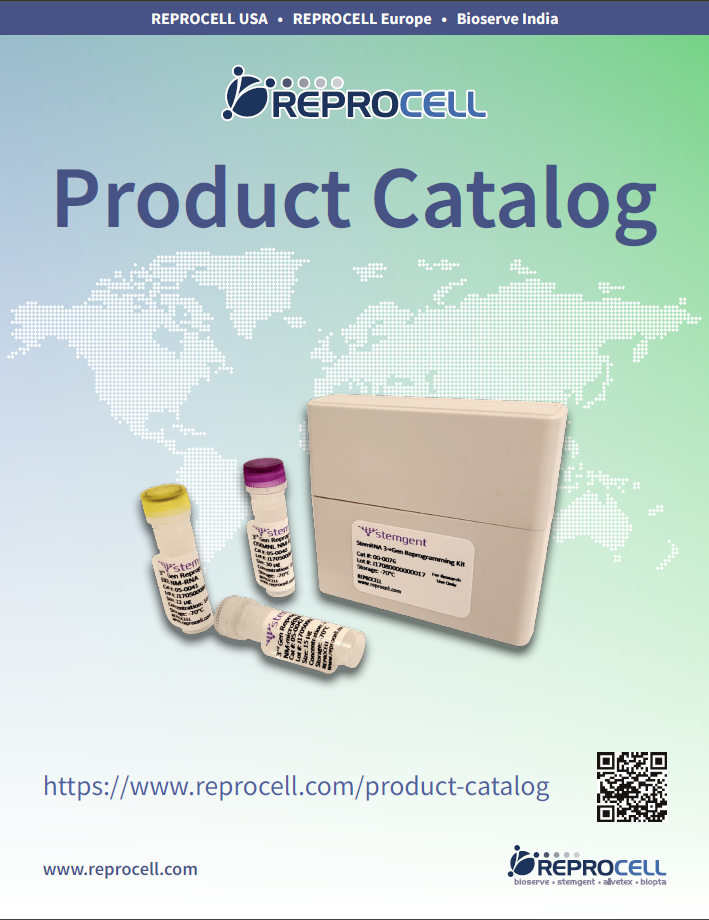REPROCELL is pleased to be a distributor of Qkine growth factors and cytokines for use with iPSCs and MSCs.
Qkine, an ISO 9001: 2015 certified company based in Cambridge, UK, are experts at microbial fermentation, manufacturing growth factors and cytokines in E. coli using recombinant DNA technology. Their cost-effective and reliable production process eliminates the use of animal-derived components, and enhances purity, quality control (QC), reproducibility, and supply-chain stability.
Qkine growth factors and cytokines are supplied lyophilized (as a freeze-dried powder) and shipped at ambient temperature, with extensive CoO, CoA and animal-free (AOF/ADCF) documentation provided for every lot.
Qkine's animal-free manufacturing process produces growth factors that are an excellent quality. All products undergo rigorous testing for purity, bioactivity, and lot-to-lot consistency, adhering to Qkine's Nine-point Quality Commitment.
Qkine's products can be utilized in serum-free and defined culture media, and where it is essential to use a source that is free of viruses, prions, carrier proteins, or other contaminants.
Applications of Qkine's growth factors and cytokines include stem cell research and maintenance, physiologically relevant organoid models, organ-on-a-chip technologies, large scale biomanufacturing, and cellular agriculture (cultured meat, fish, fat, and dairy). Qkine products are used by research institutions, pharma and biotech companies around the world.
What are Growth Factors and Cytokines?
Numerous cell signaling molecules perform essential roles in the human body, such as cell-to-cell communication, controlling growth and differentiation (cell specialization to form tissues), raising immune responses, and stimulating tissue repair. Many of these molecules are small proteins known as growth factors and cytokines. The chemical structure, role, and genetics of growth factors and cytokines have been studied for several decades, leading to breakthroughs in medicine and biotechnology.
In the early 1900s, Élie Metchnikoff and Paul Ehrlich[1, 2] proposed theories on immune system regulation, which later contributed to cytokine research. The first identified growth factor Nerve Growth Factor (NGF) was discovered by Rita Levi-Montalcini and Stanley Cohen in the early 1950s[3, 4, 5, 6]. The first E. coli expressed recombinant human protein was insulin, in the early 1950s[7]. In the decades following recombinant DNA technology has been used to produce an increasing number of growth factors and cytokines in E. coli and other non-animal systems[8, 9, 10], leading to their use as therapeutics[11] and in stem cell research[12, 13].
Growth factors and cytokines have overlapping functions but they are categorized according to their sources and primary functions in the body:
| Feature | Growth Factors | Cytokines |
| Primary Function | Cell growth; proliferation; differentiation | Immune regulation; inflammation |
| Main source | Epithelial; endothelial; fibroblast; platelets | Immune cells (T cells, macrophages, etc.) |
| Action Range | Localized effects (autocrine/ paracrine) | Often systemic effects (endocrine) |
| Examples | EGF; VEGF; PDGF; TGF-β | ILs; TNF-α; IFNs; CSFs |
Growth factors and cytokines are essential for maintaining embryonic stem cells (ESCs), induced pluripotent stem cells (iPSCs), mesenchymal stem cells (MSCs), and hematopoietic stem cells (HSCs) in culture and directing their differentiation into specialized cell types. These molecules regulate self-renewal, proliferation, and differentiation.
Why Use Qkine Growth Factors and Cytokines in your Stem Cell Research?

Qkine's growth factor and cytokine protein production facility utilizes recombinant DNA technology and expression in E.coli. This animal-origin free process eliminates variations that arise from trace animal components — enhancing consistency in your cell cultures. The risk of contamination by mammalian pathogens is also mitigated — improving the reliability of your cell products.

Qkine ensures the highest lot-to-lot consistency for all its proteins by adhering to a stringent Quality Control (QC) process. Purity and bioactivity is ensured to match prior lots, ensuring reproducibility of your cell cultures and production processes.

Qkine's high quality control standards guarantee at least 98% purity (due to assay QC assay limits), but they are confident that the true result is higher. They ensure the purity of their products by always running overloaded electrophoresis gels with 7 µg of protein to ensure that no contaminants, aggregates, or degradants are visually detected.

Qkine tests and validates the biological activity of all growth factors and cytokines against other suppliers’ proteins to ensure that what they provide has the highest level of biological activity. Hence Qkine's slogan, "Bioactivity. Guaranteed."

Besides maintaining such high levels of purity, bioactivity, and lot-to-lot consistency, Qkine's animal-origin free manufacturing process provides you with greater cost-effectiveness and greater supply-chain stability. Their lots are produced in bulk quantities, so Biotech and Pharma companies can confidently ramp up their research to production-scale using Qkine growth factors and cytokines.
Cytokines and Growth Factors from REPROCELL and Qkine are perfect for your next project. Contact us to find out more.
The following links take you to listings of Qkine's proteins that are used in stem cell culture, and are available from REPROCELL:
- Qkine growth factors and cytokines for iPSCs and ESCs
- Qkine growth factors and cytokines for MSCs
- Qkine growth factors and cytokines for HSCs
(For maintaining pluripotency, see also REPROCELL's Stemfactor™ growth factors and cytokines.)
Resources
- The Nobel Prize in Physiology or Medicine 1908 was awarded jointly to Ilya Ilyich Mechnikov and Paul Ehrlich "in recognition of their work on immunity".
- Kaufmann S, Immunology's foundation: the 100-year anniversary of the Nobel Prize to Paul Ehrlich and Elie Metchnikoff. Nat Immunol 9, 705–712 (2008). DOI: 10.1038/ni0708-705
- The Nobel Prize in Physiology or Medicine 1986 was awarded jointly to Stanley Cohen and Rita Levi-Montalcini "for their discoveries of growth factors".
- Wikipedia article on Nerve Growth Factor (NGF).
- Zeliadt N, Rita Levi-Montalcini: NGF, the prototypical growth factor, PNAS, 110 (13) 4873-4876 (2013). DOI: 10.1073/pnas.1302413110
- Jesús AR, History and Physiology of Plasmatic Growth Factors in Regenerative Medicine (PDF), J Clin Rev Case Rep, 2018.
- Lomedico PT, Use of recombinant DNA technology to program eukaryotic cells to synthesize rat proinsulin: a rapid expression assay for cloned genes, PNAS, 79(19):5798–5802 (1892). DOI: 10.1073/pnas.79.19.5798
- Beheshtizadeh N, Gharibshahian M, Bayati M, et al., Vascular endothelial growth factor (VEGF) delivery approaches in regenerative medicine, (2023). DOI: 10.1016/j.biopha.2023.115301
- Das PK, Sahoo A, Veeranki VD, Current status, and the developments of hosts and expression systems for the production of recombinant human cytokines, Biotech. Adv. (2022). DOI: 10.1016/j.biotechadv.2022.107969
- Deckers J, Anbergen T, Hokke AM, et al., Engineering Cytokine Therapeutics, Nature Reviews Bioengineering (2023). DOI: 10.1038/s44222-023-00030-y
- Mitchell AC, Briquez PS, Hubbell JA, Cochra JR, Engineering growth factors for regenerative medicine applications, Acta Biomater. 7;30:1–12(2015). DOI 10.1016/j.actbio.2015.11.007
- Venkatesan M, Semper C, Skrivergaard S, et al., Recombinant production of growth factors for application in cell culture, iScience 25, 105054 (2022). DOI: 10.1016/j.isci.2022.105054
- Imsoonthornruksa S, Pruksananonda K, Parnpai R. et al., Expression and Purification of Recombinant Human Basic Fibroblast Growth Factor Fusion Proteins and Their Uses in Human Stem Cell Culture, J Mol Microbio & Biotech, 25(6): 372–380 (2015). DOI: 10.1159/000441453







